Medieval: Total War Preview
We take a look at the upcoming real-time strategy game from the makers of Shogun that covers 400 years of European history.
To say that Medieval: Total War is simply a slight upgrade of Shogun with a change in scenery would probably be a gross understatement. To put things in perspective, Shogun only covered a small period of Japanese feudal history, but Medieval: Total War breaks away from the historical Japanese setting and also attempts to cover approximately 400 years of European history, including most major events ranging from the Crusades to the 100 Years' War. The maps in Medieval are also twice as big as those found in Shogun. It's seems like a daunting task for the development team at Creative Assembly, but they're confident that the work they've already completed on Shogun serves as a blueprint of sorts, telling them what features need refinement or even which features should be eliminated altogether in the construction of Medieval: Total War.
Though you can play the game through from the year 1095 to 1450, Medieval actually gives you the option to start a shorter campaign in any one of three specific time periods--early, middle, and late. The early period focuses mainly on the Crusades and Western Europe's conquest of lands in the Middle East whereas the late period deals with gunpowder. The game includes around 12 factions to choose from, including the Holy Roman Empire, the French, the Byzantine Empire, the English, the Italians, and others. You'll also encounter some well-known names during the campaign such as Richard the Lionheart, Genghis Khan, Marco Polo, and Joan of Arc, just to name a few of the 200 named characters.
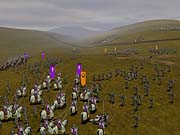
The culture that you choose is actually important in determining your position in the world, or in this case, on the map. Like Shogun, Medieval: Total War features a detailed map screen in its single-player campaign that lets you see basic tactical information such as who controls various regions surrounding your border and where enemy and allied armies are located. You'll be able to establish different trade routes--by land or sea--and you can determine the overall economic value of different regions and whether or not they can help support your steadily growing army. The map screen is also where you'll construct various buildings to increase economic prosperity and train new units (there are 100 different types of units in the game), and it gives you the opportunity to reward your generals for their work, which ultimately increases their loyalty to you and prevents them from engaging in any activities that would threaten your control over a particular region.
Creative Assembly hopes that the map screen appeals to the Civilization III and general empire-building crowds because it gives a somewhat similar overall perspective and feel to Medieval: Total War. There are even special events such as earthquakes and peasant revolts that can disrupt the peace within your own lands. Moreover, you must constantly watch your borders for enemy movements while building your own empire to the point that it can support any possible movements into enemy territories. But obviously, this isn't the real attraction of Medieval: Total War. When you invade a region held by an opposing force or an enemy decides to take your lands, you'll be brought into Medieval's massive battle sequences, which can support up to 15,000 troops at once.
Battle Tactics 101
Having to command 15,000 troops might seem overwhelming, but Medieval: Total War has been designed to limit micromanagement as much as possible, and while you're thrown into battle right away, you do have a few moments to formulate a strategy and disperse your troops accordingly. Of course, effective strategy planning depends largely on the placement of enemy troops, and in many cases (or at least in Central Europe), you can see where the enemy army is in the first minutes of a battle. Medieval's camera essentially gives you a true line of sight over the full three-dimensional terrain, limiting your field of vision to the placement of your units on the map. So there's no fog of war in the traditional sense, but your scouting abilities are basically determined by the placement of individual units or groups of units.
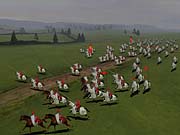
Scouting an enemy army is usually beneficial, but there are times where it can certainly backfire. During one particular battle, the enemy's forces appeared to be gathered on the other side of a small ridge, and since it wasn't a very large force, a few lines of cavalry and infantry were sent to engage them. However, a sizable portion of the enemy army was sent off to the side of the battlefield, waiting to flank the forces just sent out to deal with the "small" enemy army. These types of tactics are available to you as well, and in fact, there are certain situations where you have to be a little creative with your tactics to achieve victory. There will be battles where you can draw the enemy forces toward you by sending a smaller force out to confront them and lure them to the area where the rest of your army is waiting. This tactic is especially useful in luring an enemy army out of the castle gates so you can charge the gates with forces hidden off to the side. If you want to get even more basic than that, you can use the forests that are scattered throughout different maps to set up an ambush.
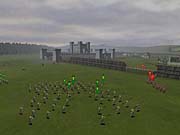
Considering Creative Assembly's desire to focus on the strategic elements of battle as opposed to the economic aspects, it's not surprising that Medieval has so many different sorts of tactics to use. None of the available tactics are really more important than basic height advantage, though. While on the desert or similarly flat maps it really doesn't make much of a difference, height advantage can change the outcome of a battle quickly--archers and war machines have greater range, and your line of sight is vastly improved, so you can make better judgments regarding the movement of your infantry or cavalry. By the same token, when an enemy has control of the high ground, you'll have to make important strategic decisions to compensate for their advantage, and those decisions could result in half of your infantry being decimated.
When you're attacking a castle or one of the various strongholds in the game, the enemy almost always has the terrain advantage because of castle walls and towers, but bombarding castle walls with catapults or similar devices that can break down castle walls will take that advantage away--though it admittedly takes time.
Before rushing into battle, it's also important to know what kinds of formations are available and how morale can affect your army.
Formations and Morale
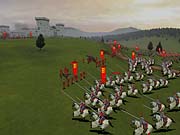
Setting up formations in Medieval: Total War is incredibly easy. With just a few mouse clicks, you can order your units to set up in different formations, ranging from basic block formations to a more offensive-oriented wedge formation. You simply click on the type of unit on the menu and then set its formation by selecting one of the corresponding images found on the top of the screen. There are a number of preset formations to choose from, and each has a different level of effectiveness depending on the circumstances of the battle. If you don't care for any of the premade formations or find that none of them are a viable choice in your situation, then you can create your own formation by selecting the units and then dragging the mouse accordingly. If you want a wide formation of archers, then you can just drag the mouse across the map farther, or conversely, you can keep a close-knit group. It's also worth noting that there are discipline ratings for units, so if they have high discipline levels, then it's more likely that they'll hold formation when engaging the enemy, but a group of soldiers with low discipline will almost immediately break formation.
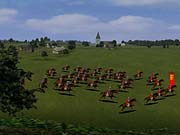
One thing to keep in mind when sending your troops off to different areas of the map is that each unit has a morale level that can be affected any number of ways. If the enemy successfully launches an ambush, the unit's morale drops. If there are too many dead bodies of fellow soldiers strewn about the battlefield, then the morale of nearby units will drop. Even height advantage can have a positive or negative impact on morale. When overall morale reaches low levels, then your troops will run away from the battlefield, becoming the helpless prey of enemy cavalry. But again, computer or human opponents have to play by the same rules, so if you successfully launch an ambush or start routing an enemy army, then the opposing force will start to run.
Field generals also play an important role in determining morale. By using the general, you can rally your troops if they're starting to run or scatter. In addition, the overall goal of the battle is to capture the enemy general, and if you happen to accomplish such a task, you can hold him for ransom to gain additional money to support your army. You can also just execute him--though doing such a thing probably wouldn't improve your relations with certain civilizations.
The battles in Medieval: Total War are detailed even at this point in development. You'll be able to see individual arrows as they soar through the air and pieces of shrapnel during bombardments, and the sheer amount of units the game can support onscreen at once makes for some truly remarkable battle scenes. We didn't get to see any of the multiplayer games in action, but we've been told that they'll support up to eight players and offer different modes like assassination, siege, and massacre. There are still some rough areas (such as sound and possible optimization issues), but for the most part, it looks as though Medieval: Total War is well on its way to making a fall release.
Got a news tip or want to contact us directly? Email news@gamespot.com
Join the conversation